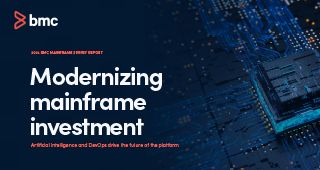Mainframe modernization is a broad topic and one that elicits symptoms of anxiety in many IT professionals. Whether the goals are relatively modest, like simply updating part of the technology stack or offloading a minor function to the cloud, or an ambitious goal like a change of platform with some or all functions heading to the cloud, surveys show it is a risky business and, indeed, there are at least five reasons to be wary. But in each case, the right strategy can help!
A focus on lift and shift of business logic
Lift and shift is easier said than done when it comes to mainframe workloads. Mainframe organizations that have good documentation and models can get some clarity regarding business logic and the actual supporting compute infrastructure. However, in practice, such information is usually inadequate. Even when the documentation and models are top notch, they can miss crucial dependencies or unrecognized processes.
As a consequence, efforts to recreate capabilities in the cloud can yield some very unpleasant surprises when the switch is flipped. That’s why many organizations take a phased and planful approach, testing the waters one function at a time and building confidence in the process and certainty in the result. Indeed, some argue that the lift and shift approach is actually obsolete.
One enabler for the more gradual approach is the ability to get mainframe data to the cloud when needed. This is a requirement for any ultimate switchover, but if it can be made easy and routine it also allows for parallel operations, where cloud function can be set up and tested with real data, at scale, to make sure nothing is left to chance and that a function equal to or better than on-premises has been achieved.
Ignoring the need for hybrid cloud infrastructure
Organizations can be forgiven for wanting to believe they can achieve a 100 percent cloud-based enterprise. Certainly, there are some valid examples of organizations that have managed this task. However, for a variety of good, practical reasons, analysts question whether completely eliminating on-premises computing is either achievable or wise.
A “Smarter with Gartner” article, Top 10 Cloud Myths, notes, “The cloud may not benefit all workloads equally. Don’t be afraid to propose non cloud solutions when appropriate.”
Sometimes there’s a resilience argument in favor of retaining on-premises capabilities. Or, of course, there may be data residency or other requirements tilting the balance. The point is that mainframe cloud migration that isn’t conceived in hybrid terms is nothing less than a rash burning of one’s bridges. And a hybrid future, particularly when enabled by smooth and reliable data movement from mainframe to cloud, can deliver the best of both worlds in terms of performance and cost-effective spending.
Addressing technology infrastructure without accounting for a holistic MDM strategy
Defined by IBM as “a comprehensive process to drive better business insights by providing a single, trusted, 360-degree view into customer and product data across the enterprise,” master data management (MDM) is an important perspective to consider in any migration plan. After taking initial steps to move data or functions to the cloud, it quickly becomes apparent that having a comprehensive grasp of data, no matter where it is located, is vital. Indeed, a 202 TDWI webinar dealt with exactly this topic, suggesting that multi-domain MDM can help “deliver information-rich, digitally transformed applications and cloud-based services.” So, without adaptable, cloud-savvy MDM, migrations can run into problems.
Assuming tape is the only way to back up mainframe data
Migration efforts that neglect to account for the mountains of data in legacy tape and VTL storage can be blindsided by how time-consuming and difficult it can be to extract that data from the mainframe environment. This can throw a migration project off-schedule or lead to business problems if backup patterns are interrupted or key data suddenly becomes less accessible. However, new technology makes extraction and movement much more feasible and the benefits of cloud data storage over tape in terms of automation, access, and simplicity are impressive.
Overlooking the value of historical data accumulated over decades
A cloud migration is, naturally, a very future-focused activity in which old infrastructure and old modes of working are put aside. In the process, organizations are sometimes tempted to leave some of their data archives out of the picture, either through simply shredding tapes no longer retained under a regulatory mandate or simply warehousing them. This is particularly true for older and generally less accessible elements.
But for enterprises fighting to secure their future in a highly competitive world, gems of knowledge are waiting regarding every aspect of the business – from the performance and function of business units, the shop floor and workforce demographics, to insights into market sectors and even consumer behavior. With cloud storage options, there are better fates for old data than gathering dust or a date with the shredder. Smart organizations recognize this fact and make a data migration strategy, the foundation for their infrastructure modernization efforts. The data hiding in the mainframe world, is truly an untapped resource that can now be exploited by cloud-based services.
Failure is not an option
Reviewing these five potential paths to failure in mainframe-cloud migration should not be misconstrued as an argument against cloud. Rather, it is intended to show the pitfalls to avoid. When considered carefully and planfully – and approached with the right tools and the right expectations – most organizations can find an appropriate path to the cloud.







